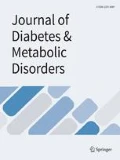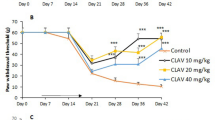Abstract
Purpose
Diabetic neuropathy is a prolonged symptom of diabetes mellitus that affect a number of diabetes mellitus patients. So far, the variants of diabetic neuropathy, either painful (PDN) or non-painful (or painless, non-PDN) response have distinctive clinical entities. This study aims to determine the effects of oxidative stress parameters and pro-inflammatory factors at spinal cord level of streptozotocin-induced diabetic neuropathy rat model.
Methods
Thirty Sprague-Dawley rats were randomly assigned to control (non-diabetic), PDN and non-PDN groups (n = 10). The rats were induced with diabetes by streptozotocin injection (60 mg/kg). Tactile allodynia and thermal hyperalgesia were assessed on day 0, 14 (week 2) and 21 (week 3) in the rats. The rats were sacrificed and the spinal cord tissue was collected for the measurement of oxidative stress (malondialdehyde (MDA), superoxide dismutase (SOD) and catalase) and pro-inflammatory markers (interleukin-1β (IL-1β) and tumour necrosis factor-α (TNF-α)).
Results
PDN rats demonstrated a marked tactile allodynia with no thermal hyperalgesia whilst non-PDN rats exhibited a prominent hypo-responsiveness towards non-noxious stimuli and hypoalgesia towards thermal input. The MDA level and pro-inflammatory TNF-α was significantly increased in PDN rats whilst catalase was reduced in these rats. Meanwhile, non-PDN rats demonstrated reduced SOD enzyme activity and TNF-α level and increased MDA and catalase activity.
Conclusion
The changes in oxidative stress parameters and pro-inflammatory factors may contribute to the changes in behavioural responses in both PDN and non-PDN rats.


Similar content being viewed by others
References
Besson JM, Chaouch A. Peripheral and spinal mechanisms of nociception. Physiol Rev. 1987;67:67–186.
Britland ST, Young RJ, Sharma AK, Clarke BF. Association of painful and painless diabetic polyneuropathy with different patterns of nerve fiber degeneration and regeneration. Diabetes. 1990;39:898–908.
Calcutt NA. Potential mechanisms of neuropathic pain in diabetes. Int Rev Neurobiol. 2002;50:205–28.
Courteix C, Eschalier A, Lavarenne J. Streptozocin-induced diabetic rats: behavioural evidence for a model of chronic pain. Pain. 1993;53:81–8.
Cui XP, Li BY, Gao HQ, Wei N, Wang WL, Lu M. Effects of grape seed proanthocyanidin extracts on peripheral nerves in streptozocin-induced diabetic rats. J Nutr Sci Vitaminol. 2008;54:321–8.
Daulhac L, Maffre V, Mallet C, Etienne M, Privat A, Kowalski-Chavuvel A, et al. Phosphorylation of spinal N-methyl-D-aspartate receptor NR1 subunits by extracellular signal-regulated kinase in dorsal horn neurons and microglia contributes to diabetes-induced paiful neuropathy. Eur J Pain. 2011;15:169. e1-12
El-Khatib AS, Moustafa AM, Abdel-Aziz AAH, Al-Shabanah OA, El-Kashef HA. Effects of aminoguanidine and desferrioxamine on some vascular and biochemical changes associated with streptozotocin-induced hyperglycaemia in rats. Pharmacol Res. 2001;43:233–40.
Fishbain DA, Cole B, Lewis JE, Gao J. What is the evidence for chronic pain being etiologically associated with the DSM-IV category of sleep disorder due to a general medical condition? A structured evidence-based review. Pain Med. 2010;11:158–79.
Fröde T, Medeiros Y. Animal models to test drugs with potential antidiabetic activity. J Ethnopharmacol. 2008;115:173–83.
Hunskaar S, Berge OG, Hole K. A modified hot-plate test sensitive to mild analgesics. Behav Brain Res. 1986;21:101–8.
Jirmanova I. Giant axonopathy in streptozotocin diabetes of rats. Acta Neuropathol. 1993;86:42–8.
Kȩdziora-Kornatowska KZ, Luciak M, Błaszczyk J, Pawlak W. Effect of Aminoguanidine on Erythrocyte Lipid Peroxiclation and Activities of Antioxidant Enzymes in Experimental Diabetes. Clin Chem Lab Med. 1998;36:771–5.
Kline KM, Caroll DG, Malnar KF. Painful diabetic peripheral neuropathy relieved with use of oral topiramate. South Med J. 2003;96
Krämer HH, Rolke R, Bickel A, Birklein F. Thermal thresholds predict painfulness of diabetic neuropathies. Diabetes Care. 2004;27:2386–91.
Malcangio M, Tomlinson DR. A pharmacologic analysis of mechanical hyperalgesia in streptozotocin-diabetic rats. Pain. 1998;76:151–7.
Martinov T, Mack M, Sykes A, Chatterjea D. Measuring changes in tactile sensitivity in the Hind paw of mice using an electronic von Frey apparatus. J Vis Exp. 2013;82:5212.
Obrosova IG. Diabetes and the peripheral nerve. Biochim Biophys Acta. 1792;2009:931–40.
Obrosova IG. Diabetic painful and insensate neuropathy: pathogenesis and potential treatments. Neurotherapeutics. 2009;6:638–47.
Obrosova IG, Fathallah L, Greene D. Early changes in lipid peroxidation and antioxidative defense in diabetic rat retina: effect of DL-α-lipoic acid. Eur J Pharmacol. 2000;398:139–46.
Pabreja K, Dua K, Sharma S, Padi SS, Kulkarni SK. Minocycline attenuates the development of diabetic neuropathic pain: possible anti-inflammatory and anti-oxidant mechanisms. Eur J Pharmacol. 2011;661:15–21.
Perovic A, Vuckovic T, Cvijic G, Djordjevic J, Davidovic V. Involvement of nitric oxide in noradrenaline-induced changes in the activity of antioxidant enzymes and lipid peroxidation in rat brown adipose tissue and heart. Physiol Res. 2008;57:95.
Sadosky A, McDermott AM, Brandenburg NA, Strauss M. A review of the epidemiology of painful diabetic peripheral neuropathy, postherpetic neuralgia, and less commonly studied neuropathic pain conditions. Pain Pract. 2008;8:45–56.
Spallone V, Greco C. Painful and painless diabetic neuropathy: one disease or two? Current Diabetes Report. 2013;13:533–49.
Tanenberg R. Painless diabetic peripheral neuropathy: the forgotten complication. Journal of Diabetes, Metabolic Disorders & Control. 2016;3:1–2.
Tanenberg RJ. Diabetic peripheral neuropathy: painful or painless. Hospital Physician. 2009;45:1–8.
Tesfaye S, Boulton AJ, Dyck PJ, Freeman R, Horowitz M, Kempler P, et al. Diabetic neuropathies: update on definitions, diagnostic criteria, estimation of severity, and treatments. Diabetes Care. 2010;33:2285–93.
Tsigos C, White A, Young R. Discrimination between painful and painless diabetic neuropathy based on testing of large somatic nerve and sympathetic nerve function. Diabet Med. 1992;9:359–65.
Tsuda M, Ueno H, Kataoka A, Tozaki-Saitoh H, Inoue K. Activation of dorsal horn microglia contributes to diabetes-induced tactile allodynia via extracellular signal-regulated protein kinase signaling. Glia. 2008;56:378–86.
Van Dam PS, Van Asbeck BS, Bravenboer B, Van Oirschot JF, Gispen WH, Marx JJ. Nerve function and oxidative stress in diabetic and vitamin E-deficient rats. Free Radic Biol Med. 1998;24:18–26.
Vincent AM, Russel JW, Low P, Feldman EL. Oxidative stress in the pathogenesis of diabetic neuropathy. Endocr Rev. 2004;25:612–28.
Vinik AI. Advances in diabetes for the millennium: new treatments for diabetic neuropathies. Medscape Gen Med. 2004;6:13.
Zulazmi NA, Gopalsamy B, Farouk AAO, Sulaiman MR, Bharatham BH, Perimal EK. Antiallodynic and antihyperalgesic effects of zerumbone on a mouse model of chronic constriction injury-induced neuropathic pain. Fitoterapia. 2015;105:215–21.
Acknowledgements
We thanked Universiti Sains Malaysia and Ministry of Higher Education for funding of Research University Grant (RUI 1001/PPSK/812139) and Fundamental Research Grant Scheme (FRGS 203/PPSK/6171189), respectively. We thanked all Physiology Laboratory, Central Research Laboratory, Maxillo-Craniofacial Laboratory, Biological Molecular Laboratory staffs and Wan Muhammad Hilmi for direct and indirect assistance and technical work.
Author information
Authors and Affiliations
Corresponding author
Ethics declarations
Conflict of Interest
There is no conflict of interest in the process of preparing this article.
Rights and permissions
About this article
Cite this article
Ismail, C.A.N., Aziz, C.B.A., Suppian, R. et al. Imbalanced oxidative stress and pro-inflammatory markers differentiate the development of diabetic neuropathy variants in streptozotocin-induced diabetic rats. J Diabetes Metab Disord 17, 129–136 (2018). https://doi.org/10.1007/s40200-018-0350-x
Received:
Accepted:
Published:
Issue Date:
DOI: https://doi.org/10.1007/s40200-018-0350-x




